THE RADIUS OF ACTION
By Andrew Maerkle
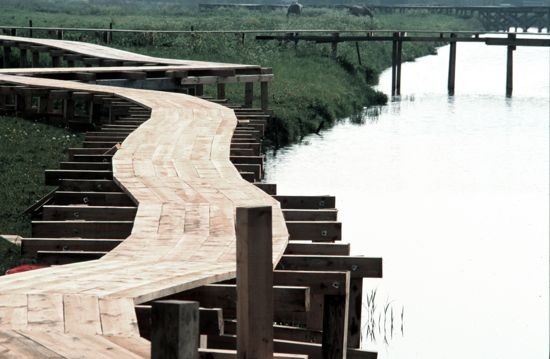 Working Progress (1996-99), work in situ, Alkmaar, The Netherlands, wood. Photo Leo van der Kleij. All images: © Tadashi Kawamata, courtesy the artist and kamel mennour, Paris.
Working Progress (1996-99), work in situ, Alkmaar, The Netherlands, wood. Photo Leo van der Kleij. All images: © Tadashi Kawamata, courtesy the artist and kamel mennour, Paris.One of Japan’s most distinguished artists, Tadashi Kawamata is known for projects that radically redefine individual relations to built space. Sometimes taking the form of walkways or raised concourses that alter the circulation or scale of public space, and at other times possessed of more sculptural dynamics, his interventions constructed from materials like scrap lumber and old chairs often develop with the involvement of the local community, and Kawamata is also active as a teacher and frequent participant in public workshops. Without necessarily being about anything, then, Kawamata’s practice embodies the discursive potential of art – its ability to set bodies and ideas in motion.
As Japan continues to confront the catastrophe of the March 11 Tohoku Earthquake and Tsunami and ensuing, ongoing nuclear crisis, ART iT met with Kawamata in Paris to ask for his views on art’s role in responding to such events, beginning with a frank assessment of the potential of the large-scale urban revitalization art project – a concept strongly associated in Japan with festivals held in rural areas like the Echigo-Tsumari Art Triennial and Setouchi International Art Festival, but also implemented to varying degrees in other localities – to serve as a platform for social contribution.
Interview:
ART iT: Since the March 11 Tohoku Earthquake and Tsunami, many in the art community in Japan have been searching for a way to respond to the catastrophe. One possible model for response is the urban revitalization art project, but such projects cannot be approached uncritically, if the integrity of art is tied to the integrity of its social benefit. Your own works often develop out of collaboration with local communities, so against this backdrop, I’d like to know what you think of art’s potential to contribute to post-3/11 reconstruction efforts.
TK: Over the years I have contributed my works to various charity causes, and I have already received several requests for donations since 3/11. However, I hesitate to rush into a direct artistic response to the catastrophe. I have no problem with those who choose to do so, but my work has always been predicated on building relations with municipalities and regions and their residents, so I am uneasy about the idea of exploiting this approach on account of the earthquake. It’s natural for people to see images from the disaster zone and feel an urgent need to contribute in some way. But often in such cases everybody rushes in one direction, addressing immediate concerns of aid and recovery without necessarily facilitating lasting exchange. This mass reaction also puts undue pressure on all people to contribute, which I feel is the situation in Japan right now, and quite disturbing in its implications. For me, now is the time to reflect on my own, and then once everyone has moved on to the next issue, it will be my turn to act.
ART iT: Can you go into greater detail about your thoughts on the concept of urban revitalization as it has been deployed in the Japanese art scene in recent years?
TK: I dislike the term “urban revitalization,” and have absolutely no interest in participating in such projects. A town cannot so simply be “revitalized.” There are many cases of pursuing revitalization for revitalization’s sake that fail to bring about any revitalization at all. Because these events are motivated by economic and other concerns, they lack a strong concept that can bring people together. They really need to be planned from much more of a long-term outlook. For example, there was a period when a number of urban revitalization art projects sprang up in various localities in Japan, but the problem was that these were completely event-based initiatives, organized with the hope that large numbers of visitors would draw attention to the region and deliver positive changes. As such, they were not sustainable, because exchange between people and the environment needs to happen on a much more fundamental level before there can be any results. This is not just about economics, but also education, or questions of how far to actually get local residents involved, or concerns over even more ambiguous connections with the community. Current urban revitalization art projects tend to be results-oriented, and this is precisely their biggest drawback.
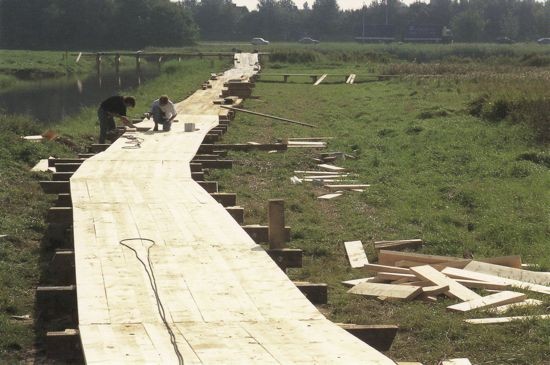 Working Progress (1996-99), work in situ, Alkmaar, The Netherlands, wood. Photo Leo van der Kleij.
Working Progress (1996-99), work in situ, Alkmaar, The Netherlands, wood. Photo Leo van der Kleij.ART iT: Then do you not consider any of your projects to be related to urban revitalization?
TK: That is correct. I have never once done anything under the premise of urban revitalization. In my projects I have always been open to the participation of locals, but not with any idea that I would be herding them around. I am happy even if only one person wants to get involved, and then as our relationship grows that might lead to connections with other people, creating a special significance for each project as it unfolds. I couldn’t say whether this leads to urban revitalization or not, but if my projects can affect in even the slightest way the awareness of the local populace, then that’s enough for me.
Maybe what I do could be called “micro revitalization” – personal revitalization. I’m not looking to bring about drastic reform. Some of my projects last several years in the same location, so these are certainly not one-off events, and in various ways they develop on a case-by-case basis, extending into the present. But I would never go so far as to believe that I could ever help revitalize an entire town.
ART iT: For example, how do you distinguish a project such as Working Progress (1996-99), commissioned by the Brijder Clinic in Alkmaar, from urban revitalization?
TK: Rather than urban revitalization, the Brijder Clinic project was an attempt to make art in a place that had not had any involvement with art until that point, and where art’s power had largely been unknown until that point. The Brijder Clinic is an addiction treatment center. I was initially approached by the clinic director to make a sculpture for the central courtyard of a new building that was being added to the complex, but I felt it would be far more interesting to do a project with the patients. At first there was resistance from the clinic, with staff voicing concerns that I could have a bad influence on the patients, or questioning what art had to do with their treatment. But I continued returning there every year to work with the patients, everybody outdoors building the walkway together, and there was a remarkable change in the patients’ attitudes over that period. For example, as recognition for the project spread, reporters started to visit. At first the patients refused to be photographed, always turning their backs to the camera such that only my face would be visible in the images that were published in the media. Yet three years later, everyone was happy to face the camera, and we could all be photographed together. After all that time working together, the patients could take pride in their involvement with the project. This was a major change for them, and I think it was possible because of the way that art engages people.
Since then, I have received numerous requests from hospitals and clinics to conduct workshops and to speak about the relations between medical care, communities and art. Of course art therapy has a long history, but I think at Alkmaar we showed that it is also possible to engage patients in an even more physical way through collaborating on an activity and making an artwork. For me, the relations between art and medical treatment, since Alkmaar, have become closely integrated. That has nothing to do with urban revitalization. What I feel was interesting about Alkmaar was the idea that there could be room in medicine to accommodate art. The town hasn’t changed at all, but I hear that people occasionally visit the clinic to see the work, and learn about how it came about.
I think that in Japan as soon as urban revitalization became consolidated as a methodology, everything became very constricted. Now, when artists go to the provinces in Japan, they are obliged to interact with the residents and cannot simply go out and make their own projects. This is particularly so in the case of large-scale events, at which community care inevitably goes hand-in-hand with urban revitalization. My concern is that this could reduce art to being nothing more than a tool for other purposes. As more obligations become attached to the commissions, artists are the ones who end up getting used. There should be room for more approaches.
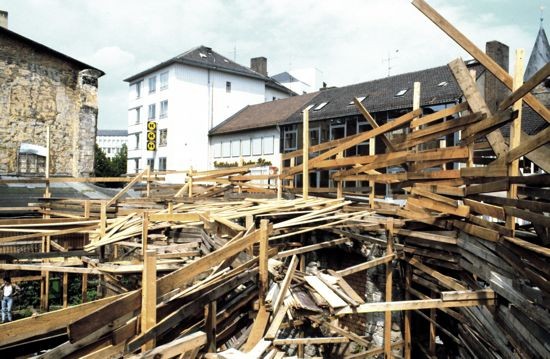
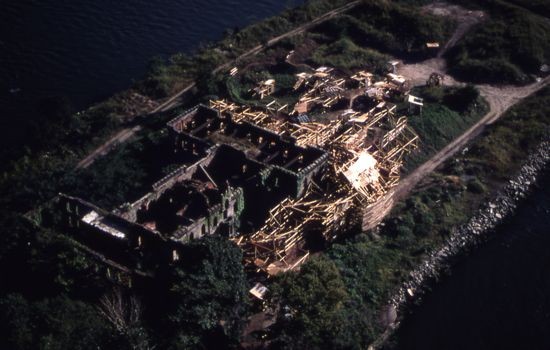 Top: Destroyed Church (1987), work in situ, Documenta 8, Kassel, Germany, wood. Photo Leo van der Kleij. Bottom: Project on Roosevelt Island (1992), installation in situ, Smallpox Hospital, Roosevelt Island, New York, USA. Photo Hisayasu Kashiwagi.
Top: Destroyed Church (1987), work in situ, Documenta 8, Kassel, Germany, wood. Photo Leo van der Kleij. Bottom: Project on Roosevelt Island (1992), installation in situ, Smallpox Hospital, Roosevelt Island, New York, USA. Photo Hisayasu Kashiwagi.ART iT: What about your projects like the Destroyed Church (1987) from Documenta 8 or Project on Roosevelt Island (1992), which made use of abandoned structures? Do these have some kind of regenerative impetus?
TK: At the time of those projects I was interested in archaeology, and approached them with the idea of excavating the historical background of the sites where they were carried out, or in another sense activating their existing characteristics to transform these sites into something entirely different. In the case of Destroyed Church, until I started working with it the site had all but disappeared from local consciousness. I started researching its history and in speaking with people found that it used to be a church, and had been destroyed during the war. Project on Roosevelt Island was the same. Some 100-odd years ago Roosevelt Island was home to an isolation ward for smallpox, and the island itself has its own historical significance. In a way these relations could only be revealed to a broader public through art. Indeed, what was interesting to see was how the project changed locals’ perceptions of the site. Art can be applied to these places that everybody has forgotten, or no longer encounters in their daily lives. Without discounting the respective methodologies of researchers and academics, art has room for all kinds of potentialities.
ART iT: As with Working Progress in Alkmaar, for both Project on Roosevelt Island and Destroyed Church you collaborated with volunteers on the production. Was there any difference between these experiences?
TK: Yes. For Destroyed Church we worked with scrap lumber to build the structure, but scrap lumber is usually not something that can be easily found. I had five assistants, all of whom were immigrants from outside of Germany, and yet working together we were able to connect with different communities to find what we needed. For instance, through the mediation of a Turkish assistant we were able to find scrap lumber from the local Turkish community.
In that sense, my assistants were not simply laborers; they were interlocutors with different communities. For the work People’s Garden (1992) for Documenta 9, I wanted to make an outdoor installation of favela-style huts, and this time had a Brazilian assistant who had actually grown up in a favela but was living in Kassel after marrying a German woman. He taught me how to build actual favela huts, and was deeply involved in realizing the work. When a work develops from the connections between locality, people and place, it is most interesting when you can achieve that kind of tight bonding or communication.
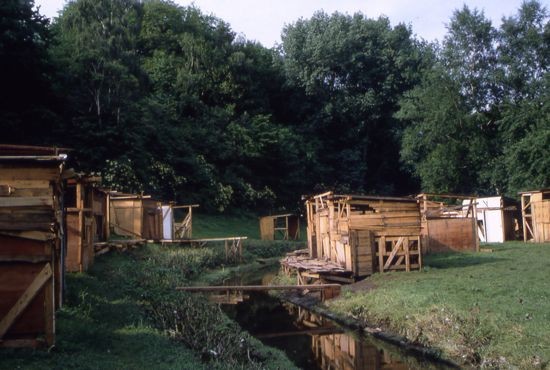 People’s Garden (1992), work in situ, Documenta 9, Kassel, Germany, wood and steel. Photo Leo van der Kleij.
People’s Garden (1992), work in situ, Documenta 9, Kassel, Germany, wood and steel. Photo Leo van der Kleij.ART iT: But in contrast with Working Progress in Alkmaar, there was no particular therapeutic element to the collaboration involved in the other works, nor were the unique relations that you had with your assistants necessarily apparent to visitors who saw these works.
TK: The average visitor to Alkmaar might not know that the walkway we constructed there is an artwork, or that it was made by people seeking treatment for drug and alcohol addiction. But if even one out of every 100 visitors takes an interest in learning more about what it actually is, then that’s enough for me. There are people with an intuitive curiosity who get it, but even those who do not realize what it is have other sensitivities that can be applied elsewhere – and it’s partly thanks to those other people that I am able to produce my works. I don’t need every single person to understand my process and methodology. I don’t need to force my work on others, or have masses of people come to see it, as long as the minimum number of people who were involved can derive some sense of satisfaction from it, and spread word about it in a grassroots fashion. I’m not doing this out of ambition. I proceed one project at a time, and enjoy a continuous stream of new commissions, each one pushing me to develop new approaches and providing me with new challenges, so I’m appreciative that I can make a living doing what I want to be doing, all while receiving some measure of recognition from others.
ART iT: In that sense I’m also curious to know more about how you conceive the temporality of your works. What kind of existence do your works have in time?
TK: I think of everything I have done over the past few decades as one continuous project. Even if the site is different, and the people involved are different, or the circumstances of the involvement are different, or there are differences in scale and material, everything is still part of one project for me. It could be Switzerland this time, Belgium the next, or a different kind of town, or a different community, but I feel my methodology does not really change. I am pursuing one continuous, ongoing project that is still in progress.
ART iT: So whether the structures themselves are still standing or no longer extant does not affect the status of the work?
TK: It’s the same. There are projects that are still standing, and those that have been destroyed, whether by accident or by design. But I can always make it again elsewhere, which is what I actually do. That’s why I feel as though it’s one continuous project that simply assumes different forms at different times. Rather than building an ever-growing body of works, it’s more like their number always remains more or less constant, because it’s all a continuation of the same project.
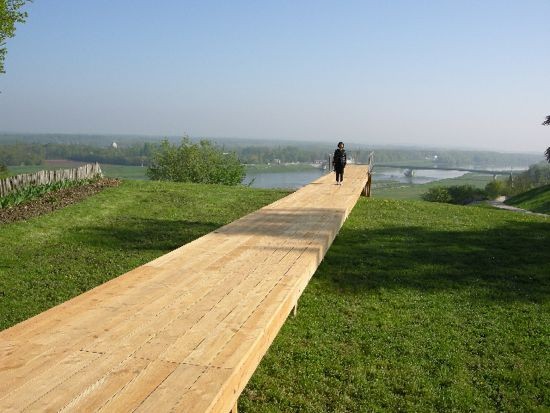 Promontoire sur la Loire (2011), work in situ, Chaumont-sur-Loire, wood.
Promontoire sur la Loire (2011), work in situ, Chaumont-sur-Loire, wood.ART iT: Do you think such a mentality imparts a degree of political agency to your works?
TK: The other day I was asked about Japan’s prospects for recovery from 3/11. I replied earthquakes are a natural phenomenon, and have occurred numerous times throughout history. Moreover, Japanese history has always been distinguished by transience. One segment of Japanese history develops in a specific time and place, and when that comes to an end then another segment develops in a different time and place, in contrast to Europe where there’s been a continuous historical development since Greek and Roman times, with the gradual formation of cities and nations. The cultural outlook itself in Japan is very provisional – quite similar in fact to how I approach my own practice. Some artists might have the idea of working toward making a masterpiece that will be collected by a museum and saved for posterity, but for me, as long as there is a memory of an action that has taken place, then it’s fine if the work itself no longer survives. I think such a mentality is not only provisional, it is also opposed to accumulation, and it is actually because it is anti-accumulative that it is sustainable. I have no ambition to make the perfect work. My only motivation is to continuously pursue the action of making works.
ART iT: If that’s the case, then what is worth preserving?
TK: It’s not material. It’s connections. It’s memories. It’s experiences. Things will eventually disappear, just as radiation disappears over time, even if it takes decades or, as with uranium, millennia. I have more faith in connections than in materials. Working together and developing camaraderie with others is what most interests me, and it’s fine if the completed work is almost a byproduct of that process. Ultimately, it’s not so much about simply saying that there’s a finished product, and that we did all this just for the sake of production; rather, I’m using art for the sake of building connections. So if one of my works gets destroyed, it’s not such a tragedy, because I will make more works. I like this idea of continuously rolling onward.
Tadashi Kawamata: The Radius of Action
